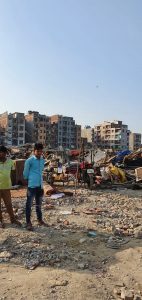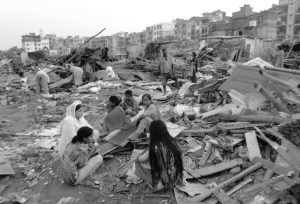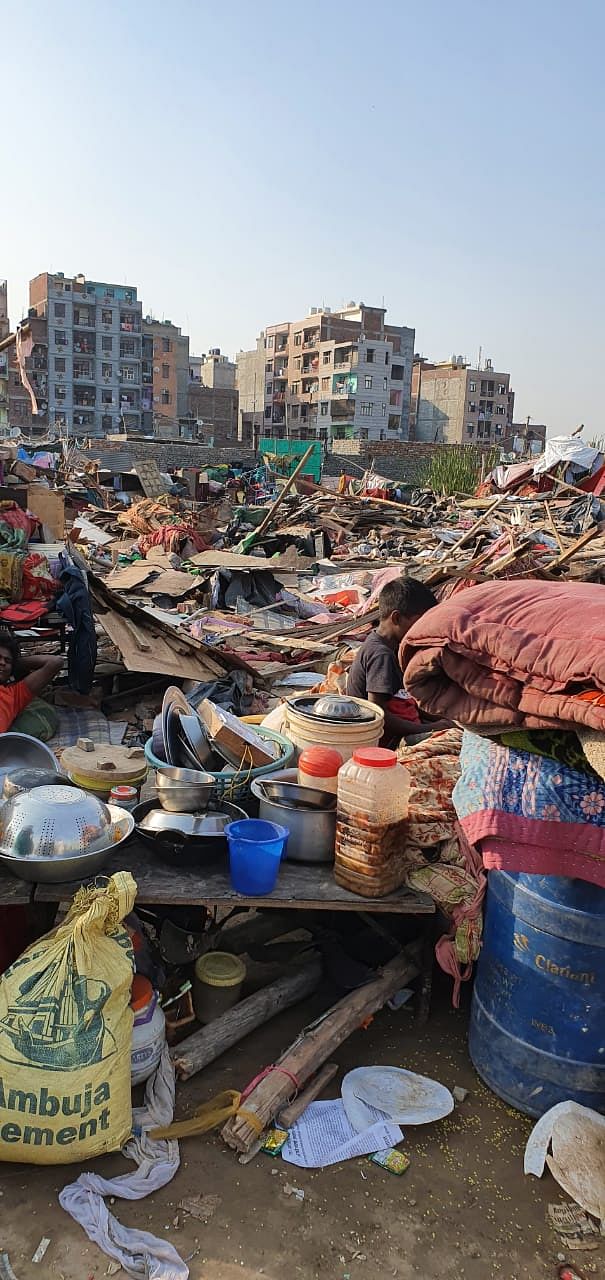Slum-dwellers are prone to face the twin wrath of poverty and an unsympathetic state. However, the law provides some relief in the form of guidelines and the Right to Resettlement. AREEB UDDIN AHMED & SHIVANSH SAXENA write on how this right was violated by the Delhi Development Authority in their recent demolition of slum dwellings or jhuggis near Dhobi Ghat.
———-
We all are going through a tough phase, and the pandemic has been a pain for everyone. But can you imagine what it would be like if in the middle of this pandemic, your shelter is demolished and you are asked to leave? This is exactly what happened in New Delhi, near the Dhobi Ghat area next to the Khaliullah Mosque on September 25.
More than 200 jhuggies have been demolished by the Delhi Development Authority.
The residents allege that no notice of eviction was served to them. Now they don’t have any shelter, let alone have access to sanitizers and ‘safety masks’. The demolition took place at around 12-1 pm. These slum dwellers don’t have any alternative accommodation and were suddenly homeless.
Demolition that defied the law
The rights of dwellers have been in question for ages and there are settled principles on how the law should regulate such eviction.
The Slum Areas (Improvement and Clearance) Act, 1956, stands inconsistent with this arbitrary move.
In the case of Ajay Maken, the Delhi High Court rightly observed that there should be efficient arrangements made by the authorities before such eviction proceedings take place. It noted:
“It is essential to first complete a survey and consult the JJ [jhuggi-jhopri] dwellers, there is, as of now, no imminent possibility of eviction of the JJ dwellers of Shakur Basti. If no in situ rehabilitation is feasible, then as and when the respondents are in a position to rehabilitate the dwellers of JJ Basti and jhuggis in Shakur Basti elsewhere, adequate time will be given to such dwellers to make arrangements to move to the relocation site. The right of the JJ dwellers to raise objections to the 2015 Policy and the Protocol and to seek legal redress at the appropriate stage, if the occasion so arises, is reserved.”



Indian Civil Liberties Union (ICLU) has been trying to help the residents faced with the demolition. Asif, one of the members of ICLU, reached out to Rashid, one of the dwellers, who said, “There was no notice served and the authorities demolished our houses with those JCBs [dozer]”
Most of them are in a state of terror as they are not just worried about food and basic amenities, but even more so about the dearth of a shelter.
The rights of dwellers have been in question for ages and there are settled principles on how the law should regulate such eviction.
The demolition has been done in pursuance of a clearance project that has been pending for years. But planning and execution do not work like this, as no written notice was served and only ‘an oral’ announcement was made.
The authorities have been acting arbitrarily and no order or notice was served to any residents. Ahmed who has been living there for seven years now, said, “No time was given to take our belongings, all the JCBs were brought in and the demolition started.”
The Slum Areas (Improvement and Clearance) Act, 1956, stands inconsistent with this arbitrary move. The act lays out the power of the competent authority, it requires for ‘the competent authority’ where it ‘is satisfied that any building in a slum area is in any respect unfit for human habitation to serve the owner of the building a notice requiring him within such time not being less than thirty days…’ The act also states that “in addition to serving a notice under this section to the owner, the competent authority may serve a copy of the notice to any other person having an interest in the building, whether as lessee, mortgagee or otherwise.”
Relevance of Supreme Court Ruling in Sudama Singh Case
In 2010, in a Delhi High Court judgment Sudama Singh, the court held that prior to carrying out any eviction, it was the duty of the state to-
(I) conduct a survey of all persons facing evictions to check their eligibility under existing schemes for rehabilitation; and
(ii) to carry out a rehabilitation exercise ‘in consultation with each one of them [persons at risk of an eviction] in a meaningful manner.’
But in this case, the court failed to acknowledge the plight of these poor dwellers who have been residing in those jhuggies for generations. And there might be a possibility that the majority of the population has been living there since 2006.
This further places a duty on the state authorities to determine the status of those jhuggies.
The ruling of Sudama Singh was upheld twice by the Supreme Court. First, though rejecting as withdrawn the special leave petition submitted by the Delhi Government against the judgment of Sudama Singh, the Supreme Court noted that the judgment had ‘attained finality’ (SLP (Civil) No. 445-446/2012). Second, when hearing an appeal against the order of the Delhi High Court, the Supreme Court upheld the judgment of Sudama Singh and ordered the Government of Delhi to enforce it ‘in full measure’ (Civil Appeal No. 21806-807/2017).
In 2010, in a Delhi High Court judgment Sudama Singh, the court held that prior to carrying out any eviction, it was the duty of the state to carry out a rehabilitation exercise ‘in consultation with each one of them [persons at risk of an eviction] in a meaningful manner.’
Also, under the Delhi Slum and JJ Rehabilitation and Relocation Policy, 2015, certain conditions have been prescribed for those who are residing in these jhuggies. The relocation policy states that if :
- Jhuggi-Jhopri [JJ] clusters which have come up before January 01, 2006, shall not be removed without rehabilitation; the cut-off date for eligibility for alternative accommodation for JJ dwellers living in these clusters would be February 14, 2015.
- No new jhuggi will be allowed to come up.
- Delhi Urban Shelter Improvement Board [DUSIB] will plan and implement In-situ rehabilitation/re-development of JJ clusters wherever technically feasible; in other cases, DUSIB will resort to the nearest possible relocation.
- Once JJ clusters are taken over by DUSIB or the Government of the National Capital Territory of Delhi [GNCTD], in-situ rehabilitation of all the clusters will be planned and implemented by DUSIB wherever feasible; in other cases, DUSIB or GNCTD will resort to the relocation of eligible JJ dwellers.
Supreme Court on Right to Shelter and Livelihood
It is important to note here that the right to shelter has been recognized as one of the facets of Article 21 under the Indian Constitution. In Olga Tellis v. Bombay Municipal Corporation, the court observed that-
“An equally important facet of that right is the right to livelihood because, no person can live without the means of living, that is, the means of livelihood. If the right to livelihood is not treated as a part of the constitutional right to life, the easiest way of depriving a person of his right to life would be to deprive him of his means of livelihood to the point of abrogation. Such deprivation would not only denude the life of its effective content and meaningfulness but it would make life impossible to live. The motive force which people their desertion of their hearths and homes in the village s that struggle for survival, that is, the struggle for life. So unimpeachable is the evidence of the nexus between life and the means of livelihood. They have to eat to live: Only a handful can afford the luxury of living to eat.”



Furthermore, the Hon’ble Supreme Court has rightly observed in Ahmedabad Municipal Corporation v. Nawab Khan Gulab Khan and ors. that — It would, therefore, be of necessity that the policy of the Government in executing the policies of providing housing accommodation either to the rural poor or the urban poor, should be such that the lands allotted or houses constructed/plots allotted be in such a manner that all the sections of the society, Schedules Castes, Scheduled Tribes, Backward Classes and other poor are integrated as cohesive social structure. The expenditure should be met from the respective budgetary provisions allotted to their housing schemes in the respective proportion be utilized. All of them would, therefore, live in one locality in an integrated social group so that social harmony, integrity, fraternity and amity would be fostered, religious and caste distinction would no longer remain a barrier for harmonised social intercourse and integration.
Hence, such eviction is against the idea of natural justice and the authorities should proceed legally. One of the residents said that some of the jhuggies have not been demolished, and the remaining ones will be evicted by around September 28.
Although not much can be done now, as we cannot get them their shelters back, the least we could do is to aid them with supplementary relief.
It is noteworthy to mention in this case what Nelson Mandela stated in one of his speeches in 1991:
“A simple vote, without food, shelter and health care is to use first-generation rights as a smokescreen to obscure the deep underlying forces which dehumanise people. It is to create an appearance of equality and justice, while by implication socio-economic inequality is entrenched. We do not want freedom without bread, nor do we want bread without freedom. We must provide for all the fundamental rights and freedoms associated with a democratic society.”
(Areeb Uddin Ahmed is a law student at Aligarh Muslim University. Shivansh Saxena is a law student at VIPS, IP University. They are associated with ICLU. Views are personal.)


